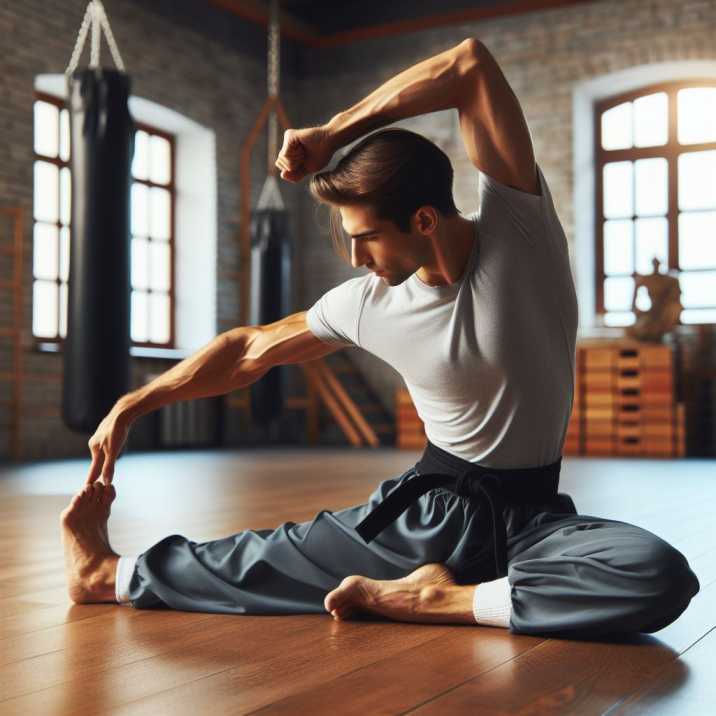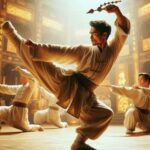Introduction:
Table of Contents
Kung Fu, an ancient Chinese martial art, is not just about punches and kicks; it’s also about developing a flexible body and mind. Flexibility plays a crucial role in mastering Kung Fu, allowing practitioners to perform various techniques with precision and agility. In this article, we’ll delve into how Kung Fu training develops flexibility and the benefits it brings.

How Does Kung Fu Training Develops Flexibility?
1. Stretching Exercises: Kung Fu training involves a series of stretching exercises designed to improve flexibility. These exercises target different muscle groups, helping to increase range of motion and reduce the risk of injury. Stretching is an essential component of Kung Fu practice, helping practitioners achieve fluid and graceful movements.
2. Dynamic Kicks: Kung Fu incorporates dynamic kicks that require a high level of flexibility. Practicing kicks like side kicks and roundhouse kicks helps improve leg flexibility, strength, and balance. Through consistent practice, Kung Fu practitioners develop the ability to execute these kicks with precision and power.
3. Forms Practice: Forms, also known as katas, are a series of choreographed movements practiced in Kung Fu. Performing forms requires fluid transitions between different stances and techniques, which demands flexibility and control. Regular practice of forms enhances overall flexibility and body coordination.
4. Stance Work: Kung Fu training emphasizes various stances, such as horse stance and bow stance, which help improve balance, strength, and flexibility. Holding these stances for extended periods challenges the muscles and increases flexibility over time.
5. Joint Mobility Exercises: Kung Fu includes joint mobility exercises that focus on improving the flexibility and range of motion of joints. These exercises help prevent stiffness and promote fluid movement during practice sessions and combat scenarios.

Benefits of Kung Fu Training:
- Improved Performance: Kung Fu Training Develops Flexibility which leads to enables practitioners to perform techniques with greater ease and efficiency, leading to improved overall performance.
- Injury Prevention: Increased flexibility reduces the risk of muscle strains and injuries during training and sparring sessions.
- Better Balance and Coordination: Flexible muscles and joints contribute to better balance, agility, and coordination, essential for mastering Kung Fu techniques.
- Fluid Movement: Flexibility allows for smoother and more fluid movement, enabling practitioners to execute techniques with precision and grace.
- Mind-Body Connection: Kung Fu training fosters a strong mind-body connection, with flexibility being a key component in achieving harmony between physical and mental aspects.
Key Information : Kung Fu Training Develops Flexibility:
| Aspect | Description |
|---|---|
| Flexibility Training Methods | Stretching exercises, dynamic kicks, forms practice, stance work, joint mobility exercises |
| Benefits of Flexibility | Improved performance, injury prevention, better balance and coordination, fluid movement, mind-body connection |
| Frequency of Practice | Aim for 3-4 sessions per week for noticeable improvements |
| Specific Stretching Exercises | Leg stretches, hip stretches, shoulder stretches |
| Suitability of Kung Fu | Suitable for people of all ages and body types |
| Timeframe for Improvement | Varies based on individual factors; improvements typically seen within a few months to a year |
| Importance of Flexibility in Self-Defense | Crucial for evading attacks, executing counterattacks, and maintaining control in combat situations |
This table provides a concise overview of the various aspects discussed in the article, making it easy for readers to grasp the key points at a glance.
Conclusion:
Kung Fu training offers a holistic approach to physical fitness and martial arts mastery, with flexibility being a cornerstone of its practice. Through stretching exercises, dynamic kicks, forms practice, stance work, and joint mobility exercises, practitioners develop not only physical flexibility but also mental discipline and focus. By understanding how Kung Fu training contributes to flexibility development, practitioners can unlock their full potential and excel in this ancient martial art form.
FAQs:
1. How often should I practice Kung Fu to improve flexibility? Consistent practice is key to improving flexibility in Kung Fu. Aim for at least three to four sessions per week to see noticeable improvements.
2. Are there specific stretching exercises I should focus on for flexibility in Kung Fu? Yes, focus on stretches that target major muscle groups used in Kung Fu, such as leg stretches, hip stretches, and shoulder stretches.
3. Can anyone learn Kung Fu, regardless of age or body type? Yes, Kung Fu is suitable for people of all ages and body types. It’s essential to find a style and training regimen that suits your individual needs and goals.
4. How long does it take to become flexible through Kung Fu training? The timeframe varies for each individual, depending on factors like starting flexibility, consistency of practice, and dedication. With regular training, flexibility improvements can be observed within a few months to a year.
5. Is flexibility important for self-defense in Kung Fu? Yes, flexibility plays a crucial role in self-defense techniques in Kung Fu, allowing practitioners to evade attacks, execute counterattacks, and maintain control in combat situations.


